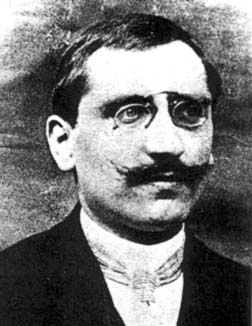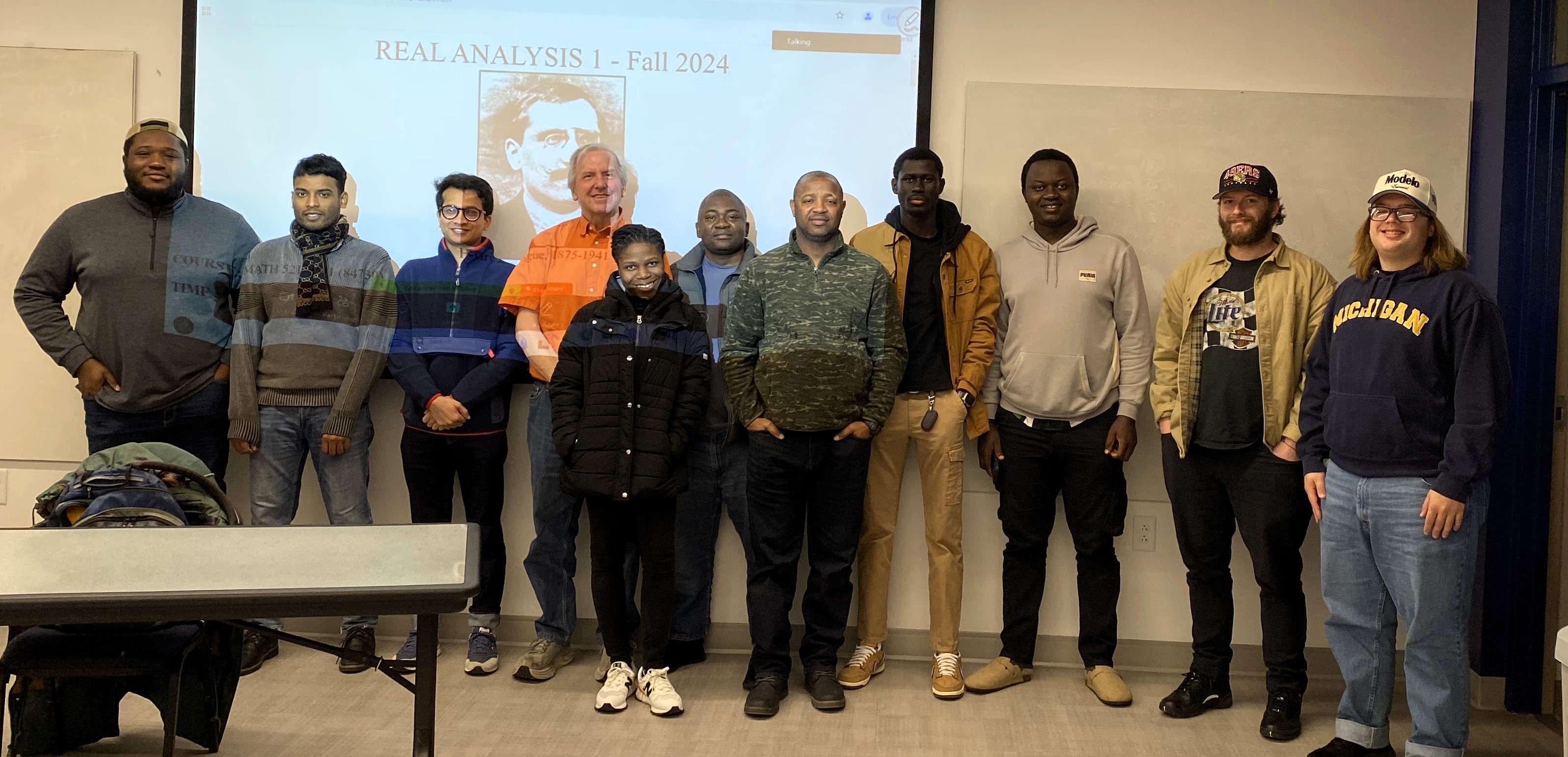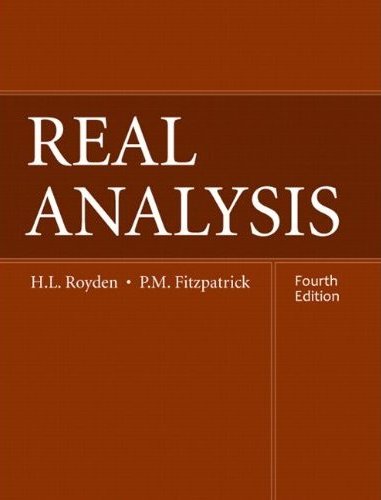
Henri Lebesgue, 1875-1941


COURSE: MATH 5210-001 (84730)
TIME: 2:55-4:15 TR, PLACE: Gilbreath Hall 104
INSTRUCTOR: Dr. Robert Gardner, OFFICE: Room 308F of Gilbreath Hall
OFFICE HOURS: 4:15-5:00 TR in Gilbreath 104 (as needed), PHONE: 439-6979 (Math Office 439-4349)
E-MAIL: gardnerr@etsu.edu
WEBPAGE: Dr. Bob's faculty webpage
TEXT: Real Analysis, Fourth Edition, by H.L. Royden and P.M. Fitzpatrick, Prentice Hall (2010).

PREREQUISITES: The prerequisite for this class is a one year sequence of senior level analysis, equivalent to our Analysis 1 and 2 (MATH 4217/5217, 4227/5227). I have online notes for Analysis 1 and Analysis 2 (but they are not nearly as thorough as the notes for several of my other classes). You MUST be familiar with this material!!! We will be busy on the new material and will only have time do a quick look-up of terms and results from the undergraduate material, when relevant. If you have not taken this background material, then this is the wrong class for you and you need to be in Analysis 1 or Analysis 2! The first homework set will address a super-quick survey of prerequisite material with an emphasis on Riemann integration.
CLASS NOTES: We will use digital notes for the component of the lecture consisting of definitions, statements of theorems, and some examples. Proofs of the vast majority of theorems, propositions, lemmas, and corollaries are available and in Beamer presentations and will be presented in class as time permits. Limited marginal notes, additional examples, and further explanations will be given using handwritten notes and a document camera. Copies of the notes are online. You should read the online notes to be covered in class before each class (we may not have class time to cover every little detail in the online notes). Try to understand the definitions, the examples, and the meanings of the theorems.
VIDEOS: Videos for most of the material covered in this class will be posted online and on YouTube. Links to videos are at: Real Analysis 1 online videos. These are very thorough and include all proofs that are in the class notes. We will cover lots of proofs during the lectures, but there won't be time to cover everything in class.
ZOOM AND ATTENDANCE: A Zoom meeting and recording of each class will be available. However, you are expected to attend in-person! In-person attendance will be informally taken during each class. If you are not feeling well or for other reasons cannot attend, let me know before class starts. The recordings will be available (if all of the technology works) and you can view them (or re-view them) as needed.
ABOUT THE COURSE: This class offers a standard introduction to the theory of functions of a real variable from the measure theoretic perspective. As commented on page 1 of the third edition of Real Analysis, we will cover "a portion of the material that every graduate student in mathematics must know." Whereas the undergraduate real analysis class presents the results of calculus from a rigorous perspective, we will introduce fundamentally new ideas which are basic extensions of the results from calculus. In particular, we will put a weight or "measure" on certain sets of real numbers. This measure will be used to define a new type of integral called the Lebesgue integral. Recall that a function is Riemann integrable if and only if it is discontinuous on a "small" set (namely, a set of measure zero). The Lebesgue integral is much more flexible and will allow us to integrate a much larger class of functions. In addition, we will have a number of "convergence theorems" related to the Lebesgue integral, which are not true in the setting of Riemann integration. The fourth edition of Real Analysis states on page x that "The general theory of measure and integration was born in the early twentieth century. It is now an indispensable ingredient in remarkably diverse areas of mathematics, including probability theory, partial differential equations, functional analysis, harmonic analysis, and dynamical systems. Indeed, it has become a unifying concept." A section of Real Analysis 2 (MATH 5220) will be offered in spring 2025, assuming there is an appropriate level of interest.
GRADING: Homework (H) to be turned in will be assigned regularly. We will have two tests (T1 and T2) and your average will be computed as follows: AVERAGE = (7H + 1.5T1 + 1.5T2)/10. Grades will be assigned based on a 10 point scale with "plus" and "minus" grades being assigned as appropriate. Based on the assignment of grade points by ETSU, the plus and minus grades should be given on a 3 point subscale. For example, a B+ corresponds to an average of 87, 88, or 89; an A- corresponds to an average of 90, 91, or 92; an A corresponds to an average of 93 to 100 (ETSU does not grant A+ grades and the highest passing grade in a graduate class is C), etc.
HOMEWORK: Homework will be assigned and collected at one week intervals. It will normally be due on Saturdays at midnight and you will be expected to submit scans in PDF of your work to D2L (so you will need a way to convert your solutions into PDF versions, either with a scanner of a phone APP). YOU MUST SHOW ALL DETAILS ON THE HOMEWORK PROBLEMS!!! Justify every step and claim you make - this is how you convince me that you know what you are doing. You may find some answers online, but these rarely sufficiently justify all steps and are unacceptable as homework solutions.
ACADEMIC MISCONDUCT: If you have any questions about the assigned homework problems, then I will try to address them in class. If you need additional information, then let me know. We can work it out through e-mail, Zoom, or in-person meetings in my office. You are not to collaborate with your classmates on homework! I expect that the work you turn in is your own and that you understand it. Some of the homework problems are fairly standard for this class, and you may find proofs online or proofs generated by a Generative Artificial Intelligence (such as mathgpt). The online proofs or AI generated proofs may not be done with the notation, definitions, and specific methods which we are developing and, since they are not your work, they are not acceptable for this class. If I get homework from two (or more) of you that is virtually identical, then neither of you will get any credit on that assignment. If you copy homework solutions from an online source, then you will get no credit. If your homework is identical to one of your classmates, with the exception of using different symbols/variables and changing "hence" to "therefore," then we have a problem! If you copy a solution from a solution manual or from a website or use AI, then we have a problem! I will not hesitate to charge you with academic misconduct under these conditions. To avoid this, do not copy homework and turn it in as your own!!! During tests, I will "patrol" the room to make sure everyone is doing their own work. Once you start a test, you must stay in the room until you complete it or until the class time is over. If you have a documented medical need to leave class during the test then this will, of course, be honored (provided you give me the documentation before hand). I will provide all paper for the tests. You will only need a pencil and eraser. You will put your backpack at the front of the classroom during the test and your phone will be placed on the table at the front of the room (so please make sure you have the phone silenced). Cheating on a test will result in a grade of 0 on that test. These are examples of academic misconduct and I will have to act on this as spelled out on ETSU's "Academic Integrity @ ETSU" webpage (last accessed 8/18/2024). When such a charge is lodged, the dean of the School of Graduate Studies is contacted. Repeated or flagrant academic misconduct violations can lead to suspension and/or expulsion from the university (the final decision is made by the School of Graduate studies and the graduate dean, Dr. McGee).
DESIRE2LEARN: I will not rely on the Desire2Learn ("elearn") website for classnotes or supplements. Instead, I will simply post this material directly on the internet. However, I will post your homework grades, homework solutions, and recordings of class lectures on D2L.
SYLLABUS ATTACHMENT: You can find an on-line version of the university's syllabus attachment (which contains general information concerning advisement, honor codes, dropping, etc.; last accessed 8/18/2024).
TENTATIVE OUTLINE:
Essential Background for Real Analysis I
Real numbers, field, ordering, least upper bounds, completeness, Cauchy sequences, lim sup, lim inf, open, closed, compact, connected, Heine Borel Theorem, cardinality, countable/uncountable, Cantor's Theorem, Continuum Hypothesis. It will be up to you to review this material outside of class. A YouTube video of this material is available.
The Riemann-Lebesgue Theorem
Riemann integral, measure zero set, oscillation, uniform convergence, convergence theorems. It will be up to you to review this material outside of class. A YouTube video of this material is available: Part 1, Part 2, Part 3.
Chapter 1: The Real Numbers (Section 4)
σ-algebras of sets, Borel sets, Fσ and Gδ sets.
Chapter 2: Lebesgue Measure
outer measure, measurable sets, inner approximation, Lebesgue measure, nonmeasurable set, Banach-Tarski Paradox, Cantor set and Cantor-Lebesgue Function.
Axiom of Choice: More Axiom of Choice and the Banach-Tarski Paradox.
Chapter 3: Lebesgue Measurable Functions
measurable functions, characteristic functions, approximation, Littlewood's principles, Egoroff's Theorem, Lusin's Theorem.
Chapter 4: Lebesgue Integration
Riemann integral, step functions, simple functions, Lebesgue integral of a bounded function, Bounded Convergence Theorem, Fatou's Lemma, Monotone Convergence Theorem, Lebesgue Dominated Convergence Theorem, general Lebesgue integral, uniform integrability.
IMPORTANT DATES: (see the official ETSU calendar for more details; accessed 8/18/2024):
| |
|
|||
| |
||||
| |
||||
| |
||||
| |
||||
| |
||||
| |
||||
| |
2.6. Nonmeasurable Sets |
2.30, 2.6.B |
||
| |
||||
| |
||||
| |
||||
Return to Bob Gardner's home page
Last updated: December 4, 2024